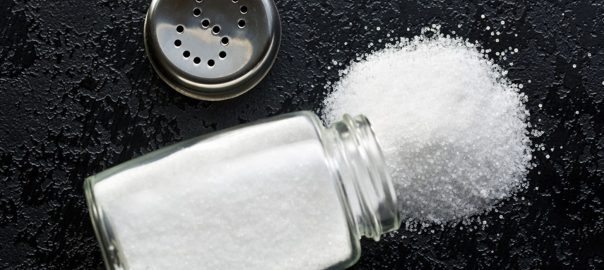
Benefits of Salt Consumption
Salt: Good or Evil?
Learn about misconceptions surrounding salt and how much of this essential mineral you should include in your diet.
Disclaimer: The information in this article is not intended to replace personalized medical advice. A low carb diet may not be suitable for you. Consult your health care provider before making any changes to your lifestyle or use this information at your own risk.
If you ask most people, they will reiterate what has been told to us by health professionals for years, that salt is “bad for us”. This belief has been a part of our culture for a long time, mainly because outdated clinical studies claimed that salt was responsible for cardiovascular disease and hypertension (high blood pressure). These studies were never based on sound evidence and have since been disproven. Cardiovascular disease and hypertension can be caused by a complex set of factors and should not be attributed to salt consumption alone. Furthermore, it should also be noted that reducing or completely eliminating salt from the diet can have adverse effects on health.
In this article, we break down the benefits of salt consumption and address the risks of over or under consumption. Also, we explain a healthy approach to including salt in your diet.
What is Salt?
Salt is made up of two minerals, sodium (40%) and chloride (60%). Since salt (also called sodium chloride) is the biggest dietary source of sodium, “salt” and “sodium” are often used interchangeably. Many varieties of natural salt also contain other important minerals, such as iodine, potassium, magnesium, calcium, iron and zinc, which are important for thyroid function, metabolism, nerve cell health, fluid balance in the body and a number of other things. Collectively, these minerals are known as “electrolytes” and without them, we could not think, move, or even live.
There are many different varieties of salt, such as white salt, grey salt, pink salt, black salt – the list goes on. Despite even the best marketing efforts, these all contain pretty similar nutrient profiles. That said, there is one important distinction to make among salt varieties, and that is whether it is natural or refined. The most common form of salt is “table salt”. This highly refined version of salt should be avoided, as many of the naturally occurring nutrients have been removed and artificial nutrients have been added back in. In addition, companies add anti-caking agents to table salt to prevent clumping, which have been approved by the FDA, but new research has shown that they could be harmful to our health. Always choose a natural sea salt or other salt labelled as “natural” to obtain the most unadulterated nutrients and avoid these harmful additives.
Benefits of Salt
One of the main functions of sodium in the body is regulating fluid levels and supporting hydration, despite the common belief that eating too much salt makes you thirstier. Salt triggers the process of osmosis, which is the movement of water across a semi-permeable membrane (i.e. cell membranes). Water will always move towards areas with higher concentrations of minerals, such as salt, in order to dilute these solutions. So, if there is more salt inside a cell, water will move across the membrane into the cell and vice versa if there is more salt outside of a cell.
Salt can keep you hydrated, especially if consumed before a workout or period of fluid loss, as it signals to the kidneys not to excrete as much fluid. More water will remain in the body to maintain the fluid balance instead of being perspired or flushed out via urine, which would cause further dehydration. In addition, if you are losing fluids due to sweat or urination, drinking water with a pinch of natural sea salt can also help replenish other electrolytes that may be lost (i.e. magnesium, potassium, etc.)
Salt also has proven benefits for better sleep, improved energy levels, better mental function, increased exercise performance, and even fertility. This is because sodium plays an important role in how our nerve cells and muscles function. Both nerves and muscles require electric currents to function. Sodium ions carry an electrical charge when dissolved in water (about 60% of the human body is water), which allows these cells to send messages to each other and produce movements, thoughts, etc.
Health Risks of Too Little Salt
For many people, salt does not need to be reduced or eliminated from the diet, and in fact, there could be many benefits to increasing our salt intake (from the right sources). Below, we discuss some of the risks associated with consuming too little salt in the diet or experiencing uncompensated sodium loss.
Sodium Deficiency
If you lose too much sodium from either frequent urination or heavy perspiration and it is not replenished through the diet, you may face some unpleasant symptoms. Sodium deficiency can also be caused by over hydration, certain medications, severe vomiting or diarrhea, hormonal changes, or heart, kidney and liver problems.
The symptoms of sodium deficiency include:
- Dehydration
- Muscle cramps or spasms
- Headaches
- Weakness or fatigue
- Cognitive impairment (especially in the elderly)
- Nausea and vomiting
- Seizures and coma (in more severe cases)
Low Carb and Ketogenic Diets
If you follow a low carb or ketogenic diet, you should be increasing your salt intake because the body tends to lose more fluids with restricted carbohydrate intake. When we reduce our carbohydrate intake, less water is required to store glucose molecules in the body. Therefore, it gets flushed out (i.e. you probably experience more frequent urination) along with sodium and other important electrolytes. As low carb and ketogenic diets become more and more popular, our notions about salt need to evolve in accordance with our new approaches to diets and health. For a homemade sugar-free electrolyte drink, see this recipe.
Sugar Cravings
One of the ways the body reacts to low sodium levels is by increasing insulin levels because insulin helps the kidneys retain sodium. When insulin levels are elevated, the only macronutrient the body can process is carbohydrates. As a result, you may crave more sugar and refined carbohydrates, leading you down a dangerous path to sugar addictions, obesity and prediabetes. So, in order to prevent overconsumption of sugar and carbs, try eating low carb salty foods when cravings strike or drinking a glass of water with a pinch of salt. This may sound totally crazy – but it is based on our biology!
Health Risks of Too Much Salt
One of the main concerns with eating too much salt is risking increased blood pressure levels, known as hypertension. Unmanaged hypertension can lead to cardiovascular problems such as heart attack and stroke. Sodium is involved in blood pressure control because it helps regulate the amount of water in the blood. If you consume too much salt, your body reacts by holding onto extra water so that the internal environment doesn’t become over concentrated with sodium. However, as a result, blood volume increases – which puts pressure on blood vessels, thus resulting in high blood pressure.
It has been shown that everyone has a different “salt sensitivity”, which determines how much of an effect consuming salt has on one’s blood pressure levels. About three quarters of the population, even those with prehypertension, are not sensitive to the effects that salt has on blood pressure levels. However, about 60% of those with existing hypertension are salt-sensitive, meaning that their blood pressure will rise if they consume more than the daily recommended amount of sodium (about 6g of salt per day for adults). Salt sensitivity is a genetic trait that is thought to have given survival advantages to early humans who lived in environments where salt was scarce. So, as you can see, for the majority of the population and even certain people with high blood pressure, salt need not bear the blame for elevated blood pressure. For more on this topic, check out this article.
What is more important than cutting salt for those struggling with hypertension is losing weight and making more wholistic dietary and lifestyle changes. These can combat the myriad of factors that affect cardiovascular health rather than focusing on one singular (and negligible) cause.
Hypernatremia
Hypernatremia is a condition in which there is too much sodium in the blood. This can occur in older adults who do not eat or drink enough or become sick and suffer from severe dehydration. You may also be at greater risk for hypernatremia if you are taking certain medications, suffer from poorly controlled diabetes, have a kidney disease, or become ill causing dehydration. The main symptoms of hypernatremia include excessive thirst, lethargy, confusion, muscle spasms, and in severe cases, seizure or coma may occur. The onset of hypernatremia can occur within 24-48 hours, and treatment usually involves increased fluid intake.
Foods That Are High in Salt
The health problems associated with a high salt diet may not be solely attributed to sodium. Many foods that are high in sodium also happen to be high in other substances that are harmful to our health, such as trans fats, sugars and chemical additives.
Foods high in sodium that you should avoid include:
- Fast food
- Restaurant food
- Salted snack foods
- Canned foods
- Processed meats including sausages, bacon and cold cuts
- Processed dairy (such as string cheese, cream cheese, dry/powdered cheese, and cheese sauces)
- Frozen meals and breaded meats
- Roasted and salted nuts
- Sauces and condiments (check labels)
Foods that naturally contain high sodium levels and don’t need to be avoided include:
- Pickled foods
- Olives
- Soy sauce or tamari
- Seaweed or kombu
- Celery
- Artichokes
- Spinach and chard
- Shellfish
- Meat
- Eggs
- Dairy, especially cheeses
Recommended Salt Intake
The body requires a minimum of 500mg of sodium a day to survive (this is equal to about one quarter of a teaspoon). Health organizations encourage people to consume no more than 2,300mg of salt a day, which is around one teaspoon. Adding a pinch of natural salt to meals or water before a workout is perfectly fine under these guidelines. Some good options for high quality salts include natural sea salt, pink Himalayan salt, Celtic grey sea salt, and Redmond sea salt. But once again, just look for anything that is unrefined and contains no preservatives.
What you should be mindful of is packaged and processed foods as well as food you order from restaurants. Most, if not all, of these tend to be oversalted with the wrong kind of salt, and they may contain other harmful ingredients for your health.
Here are some great salty snack options that are minimally processed:
- Handfuel Dry Roasted Pistachios with Himalayan Salt
- House of Macadamias provides a premium and satisfying macadamia snack for nut enthusiasts
- Chocolate Sea Salt
- The Ketonut Pork Rinds deliver a crunchy, salty snack, making them a satisfying low-carb option
Stay Connected
We hope this article helped you understand the advantages and disadvantages of salt, and which to buy and which to avoid when it comes to your own salt consumption. Please let us know how we did by leaving a Google Review. And if you’d like to join our conversation, please follow us on Facebook and Instagram.
Also, for the latest low carb and keto news, please subscribe to our weekly newsletter, where you can also find the best selection of on sale low carb, keto friendly and sugar free products!






